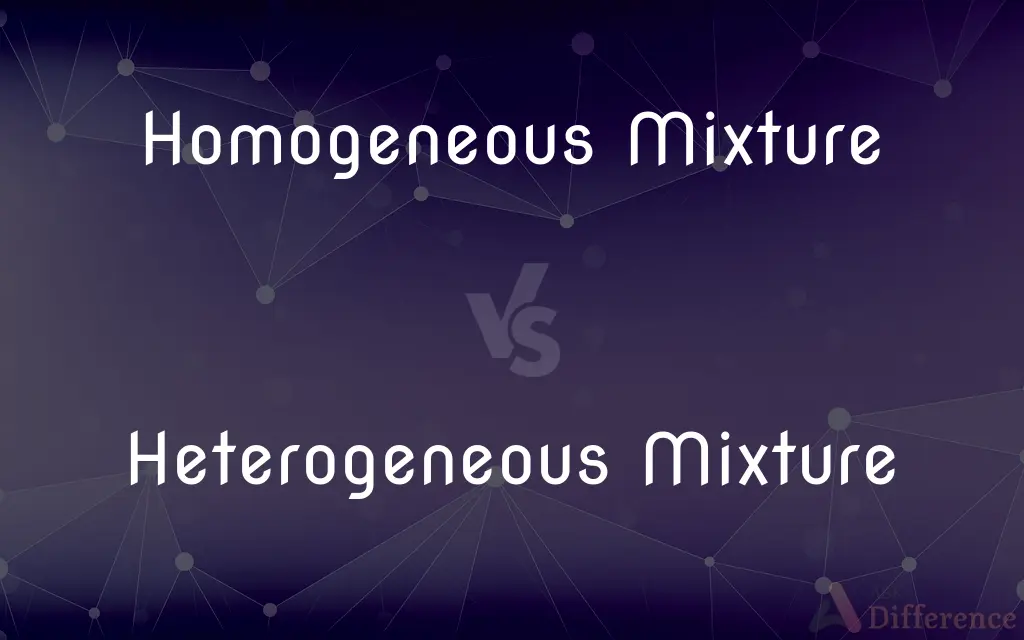Homogeneous Mixture vs. Heterogeneous Mixture — What's the Difference?
By Maham Liaqat & Urooj Arif — Published on March 8, 2024
Homogeneous mixtures have uniform composition throughout, like saltwater, while heterogeneous mixtures contain visibly distinct parts, such as salad. The key difference lies in the uniformity of component distribution.

Difference Between Homogeneous Mixture and Heterogeneous Mixture
Table of Contents
ADVERTISEMENT
Key Differences
In a homogeneous mixture, the components are uniformly distributed on a molecular level, resulting in a single-phase system where the composition is consistent throughout. Examples include solutions like air and vinegar, where the individual components cannot be distinguished by the naked eye.
Heterogeneous mixtures are characterized by their non-uniform composition, containing two or more phases where the individual substances remain physically separate. This can be observed in mixtures like oil and water or a bowl of cereal, where the different components are visibly distinguishable.
The scale of observation matters in differentiating these mixtures. Homogeneous mixtures appear uniform even under a microscope, meaning particles are mixed on a very fine level. Heterogeneous mixtures, however, will show distinct phases or particles under microscopic examination, revealing their lack of uniformity.
Physical properties such as boiling point and freezing point can also help distinguish between homogeneous and heterogeneous mixtures. Homogeneous mixtures have consistent physical properties throughout, while heterogeneous mixtures may exhibit varying properties in different parts of the mixture.
The separation techniques for these mixtures differ due to their distinct compositions. Homogeneous mixtures often require chemical methods for separation, like distillation or chromatography, whereas heterogeneous mixtures can usually be separated through physical means such as filtration or decantation.
ADVERTISEMENT
Comparison Chart
Composition
Uniform throughout
Non-uniform, visibly distinct parts
Phases
Single-phase
Multi-phase
Observation
Uniform even under a microscope
Distinct phases or particles under a microscope
Physical Properties
Consistent throughout
May vary throughout the mixture
Separation Techniques
Chemical methods (distillation, chromatography)
Physical methods (filtration, decantation)
Compare with Definitions
Homogeneous Mixture
Single-phase system, regardless of the state of matter.
Alloys like brass are solid homogeneous mixtures.
Heterogeneous Mixture
Can usually be separated by physical means.
Oil and water, a heterogeneous mixture, can be separated by decantation.
Homogeneous Mixture
Often requires chemical methods for component separation.
Alcohol can be separated from water by distillation, a method for homogeneous mixtures.
Heterogeneous Mixture
Properties may vary within the mixture.
A chocolate chip cookie, a heterogeneous mixture, has different textures and tastes in one bite.
Homogeneous Mixture
Appears the same throughout, even under magnification.
Vinegar is a homogeneous mixture of acetic acid in water.
Heterogeneous Mixture
A mixture where components are not uniformly distributed.
A salad is a heterogeneous mixture of vegetables and dressing.
Homogeneous Mixture
Has consistent physical properties across the mixture.
Air is a homogeneous mixture with uniform properties.
Heterogeneous Mixture
Contains visibly distinct parts or phases.
Sand in water forms a heterogeneous mixture with clear separation.
Homogeneous Mixture
A mixture with a uniform composition throughout.
Salt dissolved in water forms a homogeneous mixture.
Heterogeneous Mixture
Multi-phase system, visible to the naked eye or under magnification.
Ice cubes in soda demonstrate a heterogeneous mixture of solid and liquid phases.
Common Curiosities
How can you identify a heterogeneous mixture?
A heterogeneous mixture contains visibly distinct components or phases.
Can the components of a homogeneous mixture be separated?
Yes, but it often requires chemical separation methods like distillation.
Why are homogeneous mixtures single-phase?
Because their components are mixed uniformly at the molecular level, presenting no visible separation.
Why might a heterogeneous mixture show different properties in its components?
Because its components retain their individual properties and are not uniformly mixed.
What defines a homogeneous mixture?
A homogeneous mixture has a uniform composition and appearance throughout its entirety.
Do homogeneous mixtures have variable physical properties?
No, their physical properties are consistent throughout the mixture.
What is an example of a physical method to separate a heterogeneous mixture?
Filtration or decantation can physically separate components of a heterogeneous mixture.
What is an example of a homogeneous mixture in daily life?
Air is an everyday example of a homogeneous mixture.
Why are separation techniques different for these mixtures?
Because of their different physical properties and component distribution, requiring appropriate methods for effective separation.
Can heterogeneous mixtures become homogeneous?
Yes, through processes like dissolving or thorough mixing, some heterogeneous mixtures can become homogeneous.
Can a mixture be both homogeneous and heterogeneous?
A mixture cannot be both at the same time, but its classification can change with the scale of observation or after undergoing a physical or chemical process.
Can you see the different components of a homogeneous mixture under a microscope?
No, because the mixture is uniform at a molecular level.
What role does scale of observation play in identifying mixture types?
Homogeneous mixtures appear uniform at any scale, while heterogeneous mixtures show non-uniformity under magnification.
How does the phase of matter affect whether a mixture is homogeneous or heterogeneous?
The phase doesn’t determine the type; both mixtures can occur in any state of matter, depending on component distribution.
Is salad dressing homogeneous or heterogeneous?
It can be either, depending on the type. Oil and vinegar dressing is heterogeneous, while mayonnaise is homogeneous.
Share Your Discovery

Previous Comparison
Catholic Bible vs. NIV Bible
Next Comparison
Catholic Bible vs. Christian BibleAuthor Spotlight
Written by
Maham LiaqatCo-written by
Urooj ArifUrooj is a skilled content writer at Ask Difference, known for her exceptional ability to simplify complex topics into engaging and informative content. With a passion for research and a flair for clear, concise writing, she consistently delivers articles that resonate with our diverse audience.
















































